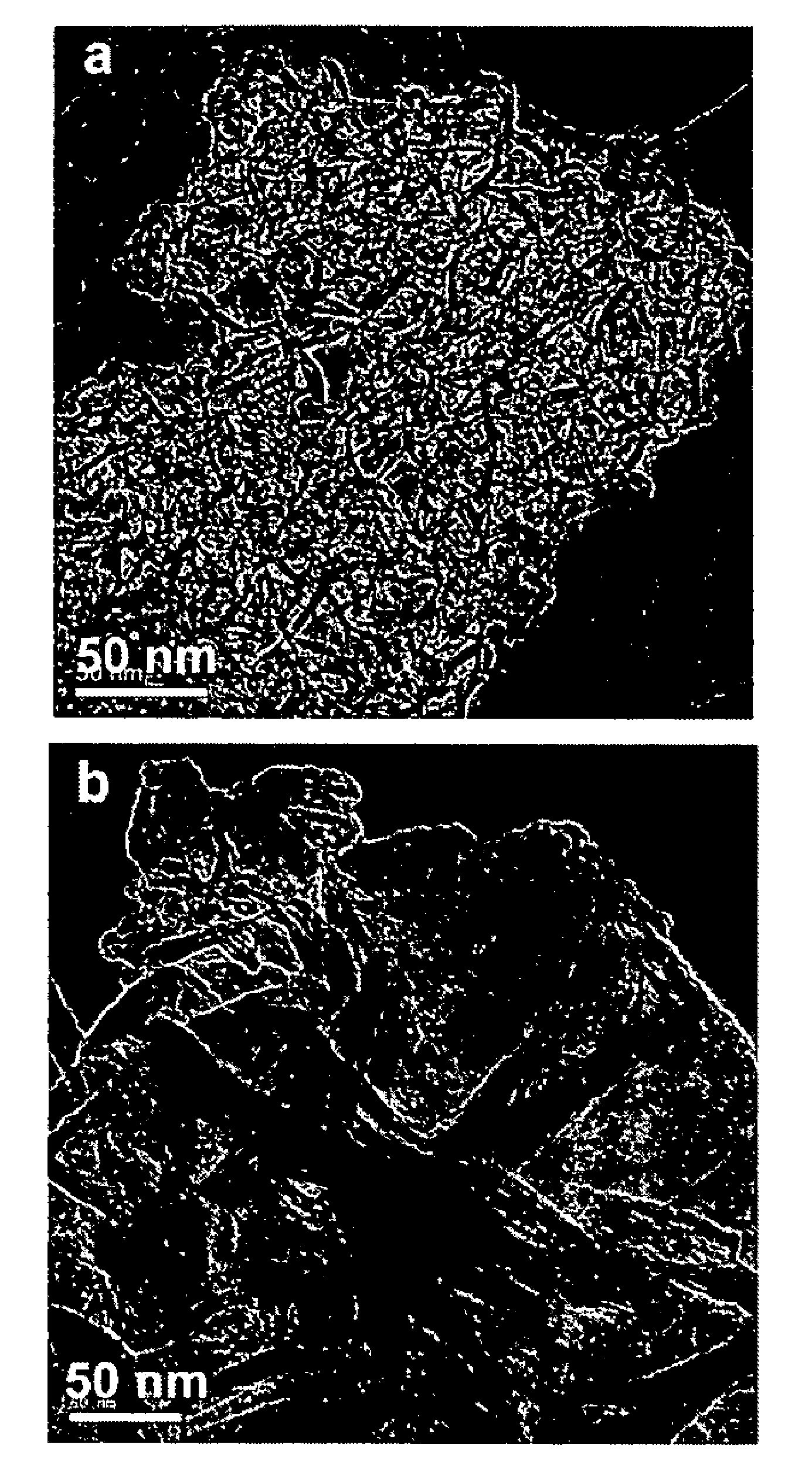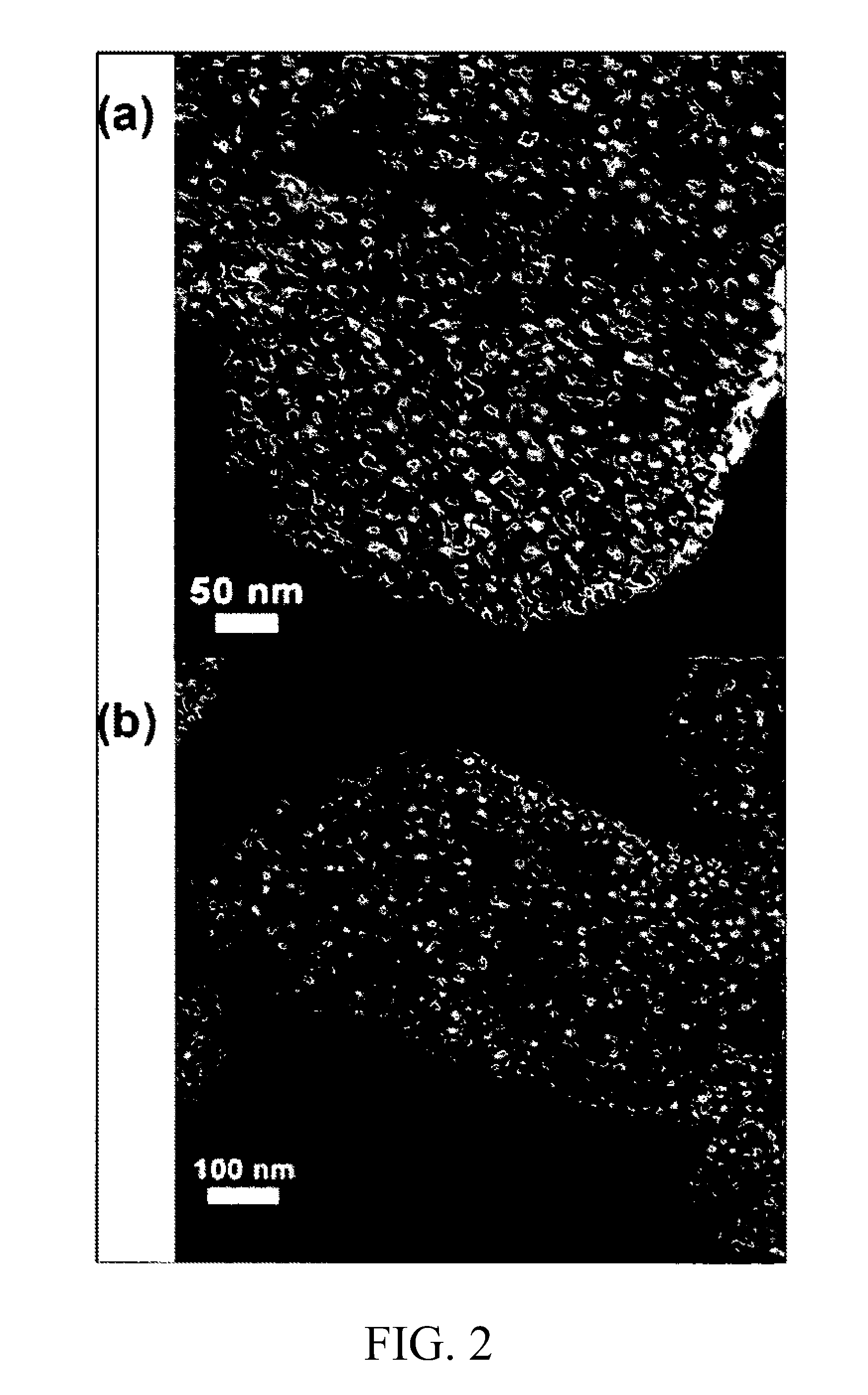Composites Comprising Polymer and Mesoporous Silicate
a technology of mesoporous silicate and polymer, which is applied in the direction of transportation and packaging, special tyres, tyre parts, etc., can solve the problems of increasing fabrication costs, lowering the strength and thermal stability of composites, and compromising the benefit of clay by organic modifiers, so as to avoid the cost and processing limitations of organic modifiers, improve thermal stability and permeability, and promote the dispersion of mesoporous silica
- Summary
- Abstract
- Description
- Claims
- Application Information
AI Technical Summary
Benefits of technology
Problems solved by technology
Method used
Image
Examples
example 1
[0101]This example illustrates the properties of as-made, amine surfactant-intercalated MSU-J mesostructured silica with a wormhole mesopore network for the synthesis of epoxy-silica mesocomposites. The as-made product contains the intercalated amine surfactant (Jeffamine D2000), which served as the surfactant for templating the ordered mesoporous silica, and as the curing agent for the formation of a rubbery epoxy nanocomposite. For comparison purposes we also have used the calcined surfactant-free calcined version of MSU-J silica for epoxy composite formation. The three-dimensional wormhole (See J. Lee, S. Yoon, S. M. Oh, C. H. Shin, Hyeon, T. Adv. Mater. 2000, 12, 359 and J. Lee, S. Han, T. Hyeon, J. Mater. Chem. 2004, 14, 478) pore network of MSU-J silica with an average mesopore size of 5.3 nm, a total pore volume of 1.41 cm3 / g and a high surface area of 947 m2 / g is shown to substantially improve the tensile properties of the polymer. Also, this example illustrates the unexpect...
example 2
[0105]This example demonstrates the reinforcement of a polar thermoset polymer (an epoxy) by a surfactant-templated mesocellular foam silica, denoted MSU-F.
[0106]Mesocellular foam structures exhibit very large average cell sizes (typically 25-35 nm) and window sizes (typically 7-18 nm) and high pore volumes up to 3.5 cm3 / g. Depending on the reaction conditions used to assemble the foam structure (see P. Schmidt-Winkel, W. W. Lukens, D. Y. Zhao, P. D. Yang, B. F Chmelka, G. D. Stucky, J. Am. Chem. Soc. 1999, 121, 254; J. S. Lettow, Y. J. Han, P. Schmidt-Winkel, P. D. Yang, D. Y. Zhao, G. D. Stucky, J. Y. Ying, Langmuir 2000, 16, 8291; and S. S. Kim, T. R. Pauly, T. J. Pinnavaia, Chem. Commun. 2000, 1661, the ratio of cell size to window size can be varied from about 1.5, corresponding to so-called “open cell forms”, to larger ratios representative of so-called “closed cell” derivatives. Mesocellular foam silicas prepared from sodium silicate, denoted MSU-F, are particularly promising...
example 3
[0111]This example illustrates the properties of a synthetic mesoporous layered silicate clay (saponite, a smectite clay, see X. Kornmann, H. Lindberg, L. A. Berglund, Polymer 42 (2001) 1303 and J. T. Kloprogge, J. Breukelaar, J. B. H. Jansen, J. W. Geus, Clays Clay Miner. 41 (1993) 103) for the reinforcement of epoxy polymers. The mesoporosity of the synthetic clay used in this example results from the disordered edge-to-face aggregation of crystalline 1-nm thick nanolayers approximately 50 nm or less in diameter without regular face-to-face stacking of the nanolayers. The nanolayers of conventional smectite clays aggregate primarily through regular face-to-face nanolayer stacking and lack the mesoporosity needed for the effective reinforcement of an engineering polymer.
[0112]The dispersion of the clay aggregates in the epoxy pre-polymer is achieved without the need for organic cation modification of the nanolayer surfaces through ion exchange with alkylammonium ions. Thus, it is p...
PUM
| Property | Measurement | Unit |
|---|---|---|
| Fraction | aaaaa | aaaaa |
| Percent by mass | aaaaa | aaaaa |
| Diameter | aaaaa | aaaaa |
Abstract
Description
Claims
Application Information
 Login to View More
Login to View More - R&D
- Intellectual Property
- Life Sciences
- Materials
- Tech Scout
- Unparalleled Data Quality
- Higher Quality Content
- 60% Fewer Hallucinations
Browse by: Latest US Patents, China's latest patents, Technical Efficacy Thesaurus, Application Domain, Technology Topic, Popular Technical Reports.
© 2025 PatSnap. All rights reserved.Legal|Privacy policy|Modern Slavery Act Transparency Statement|Sitemap|About US| Contact US: help@patsnap.com



